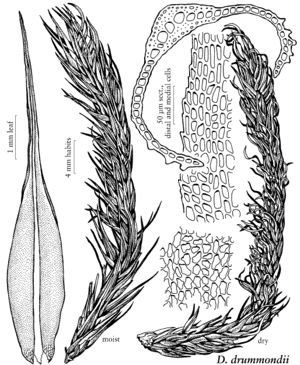Difference between revisions of "Dicranum drummondii"
Syn. Musc. Frond. 1: 356. 1848,.
imported>Volume Importer |
imported>Volume Importer |
||
| Line 49: | Line 49: | ||
|publication year= | |publication year= | ||
|special status= | |special status= | ||
| − | |source xml=https:// | + | |source xml=https://bitbucket.org/aafc-mbb/fna-data-curation/src/2e0870ddd59836b60bcf96646a41e87ea5a5943a/coarse_grained_fna_xml/V27/V27_578.xml |
|genus=Dicranum | |genus=Dicranum | ||
|species=Dicranum drummondii | |species=Dicranum drummondii | ||
Latest revision as of 21:27, 5 November 2020
Plants in loose tufts, yellowish green to yellowish brown below, shiny to dull. Stems 5–11 cm, densely tomentose below with reddish brown rhizoids. Leaves erect and compressed to somewhat flexuose, curled to flexuose at apices when dry, undulate or rugose, (7–)8–10(–12) × 1.5–2 mm, concave below, keeled above, from an oblong-ovate base to a long-acuminate apex; margins incurved to tubulose below, plane and strongly serrate above; laminae 1-stratose below, sometimes a few scattered 2-stratose regions above; costa percurrent to shortly excurrent, 1/10–1/6 the width of leaves at base, papillose to serrate above on abaxial surface, without lamellae, with a row of guide cells, two stereid bands above and below extending to apex, adaxial epidermal layer of cells with a few cells slightly larger than the stereids differentiated, the abaxial layer completely differentiated with cells slightly larger than the stereids; cell walls between lamina cells not bulging; leaf cells smooth or a few cells prorate on abaxial surface; alar cells 2-stratose, differentiated, extending to costa; proximal laminal cells irregularly rectangular, often narrowed at ends, narrow and elongate on margins, pitted, (67–)82–98(–112) × (5–)6–8(–9) µm; distal laminal cells round, oblong, somewhat rectangular, with a few pits (9–)13–19(–30) × (3–)6–9(–12) µm. Sterile, no sex organs seen. [Sexual condition pseudomonoicous, male plants on leaves of female plants. Interior perichaetial leaves abruptly subulate, convolute-sheathing. Seta 3–5 cm, 2–3 per perichaetium, sometimes solitary, yellowish. Capsule 2.5–3.5 mm, arcuate, inclined to horizontal, striate when dry, yellowish brown; operculum 2.3–3 mm. Spores 14–18 µm.]
Habitat: As large clones in mesic mire.
Distribution
Alaska, n Europe, Asia (China, Japan, Korea, Russia).
Discussion
Dicranum drummondii, primarily an Eurasian species, was for years confused with the endemic North American species Dicranum ontariense W. L. Peterson (see discussion under 9. D. ontariense). It was only recently (August 2000) that W. B. Schofield, S. S. Talbot, and S. L. Talbot made the first and only collection of the species, which was sterile, from Attu Island in the Aleutian Islands. The species is best recognized by its robust size, stems 5–11 cm, its leaves yellowish green to yellowish brown, undulate or rugose, erect and compressed, becoming flexuose at the tips when dry, concave below and keeled above, with an oblong-ovate base, becoming long-acuminate at apex, margins strongly toothed above, and costa percurrent to shortly excurrent, without lamellae. Microscopically, distinguishing characters are the leaves in the distal part with round, oblong, somewhat rectangular cells with few pits, cells smooth or prorate on abaxial surface, in cross section the lamina with a few scattered 2-stratose cells, cells walls between the lamina cells not bulging, and costa with a few cells differentiated on the adaxial epidermal surface.
Selected References
None.
